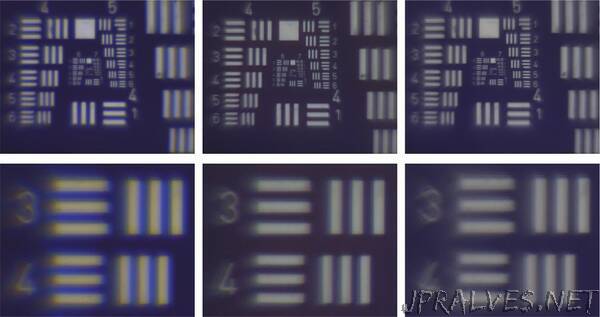
“Tiny lenses could correct color distortions for digital cameras and medical endoscopes
In a new study, researchers have shown that 3D printing can be used to make highly precise and complex miniature lenses with sizes of just a few microns. The microlenses can be used to correct color distortion during imaging, enabling small and lightweight cameras that can be designed for a variety of applications.
“The ability to 3D print complex micro-optics means that they can be fabricated directly onto many different surfaces such as the CCD or CMOS chips used in digital cameras,” said Michael Schmid, a member of the research team from University of Stuttgart in Germany. “The micro-optics can also be printed on the end of optical fibers to create very small medical endoscopes with excellent imaging quality.”
In The Optical Society (OSA) journal Optics Letters, researchers led by Harald Giessen detail how they used a type of 3D printing known as two-photon lithography to create lenses that combine refractive and diffractive surfaces. They also show that combining different materials can improve the optical performance of these lenses.
“3D printing of micro-optics has improved drastically over the past few years and offers a design freedom not available from other methods,” said Schmid. “Our optimized approach for 3D printing complex micro-optics opens many possibilities for creating new and innovative optical designs that can benefit many research fields and applications.”
Pushing the limits of 3D printing
Two-photon lithography uses a focused laser beam to solidify, or polymerize, a liquid light-sensitive material known as photoresist. The optical phenomenon known as two-photon absorption allows cubic micrometer volumes of the photoresist to be polymerized, which enables fabrication of complex optical structures on the micron scale.
The research team has been investigating and optimizing micro-optics made with two-photon lithography for the past 10 years. “We noticed that color errors known as chromatic aberrations were present in some of the images created with our micro-optics, so we set out to design 3D printed lenses with improved optical performance to reduce these errors,” said Schmid.
Chromatic aberrations occur because the way that light bends, or refracts, when it enters a lens depends on the color, or wavelength, of the light. This means that without correction, red light will focus to a different spot than blue light, for example, causing fringes or color seams to appear in images.
The researchers designed miniature versions of lenses traditionally used to correct for chromatic aberrations. They began with an achromatic lens, which combines a refractive and diffractive component to limit the effects of chromatic aberration by bringing two wavelengths into focus on the same plane. The researchers used a commercially available two-photon lithography instrument made by NanoScribe GmbH to add a diffractive surface to a printed smooth refractive lens in one step.
They then took this a step further by designing an apochromatic lens by combining the refractive-diffractive lens with another lens made from a different photoresist with different optical properties. Topping the two-material lens with the refractive-diffractive surface reduces chromatic aberrations even more, thus improving imaging performance. The design was performed by Simon Thiele from the Institute of Technical Optics in Stuttgart, who recently spun out the company PrintOptics which gives customers access to the entire value chain from design over prototyping to a series of micro-optical systems.
Testing the micro-optics
To show that the new apochromatic lens could reduce chromatic aberration, the researchers measured the focal spot location for three wavelengths and compared them to a simple refractive lens with no color correction. While the reference lens with no chromatic correction showed focal spots separated by many microns, the apochromatic lenses exhibited focal spots that aligned within 1 micron.
The researchers also used the lenses to acquire images. Images taken using the simple reference lens showed strong color seams. Although the 3D printed achromat reduced these drastically, only images taken with the apochromat completely eliminated the color seams.
“Our test results showed that the performance of 3D printed micro-optics can be improved and that two-photon lithography can be used to combine refractive and diffractive surfaces as well as different photo resists,” said Schmid.
The researchers point out that fabrication time will become faster in the future, which makes this approach more practical. It currently can take several hours to create one micro-optical element, depending on size. As the technology continues to mature, the researchers are working to create new lens designs for different applications.
Paper: M. Schmid, F. Sterl, S. Thiele, A. Herkommer, H. Giessen, “3D Printed Hybrid Refractive/Diffractive Achromat and Apochromat for the Visible Wavelength Range,” Opt. Lett., 46, 10, 2485-2488 (2021).
DOI: https://doi.org/10.1364/OL.423196.”
